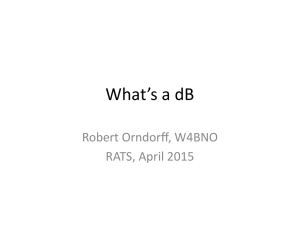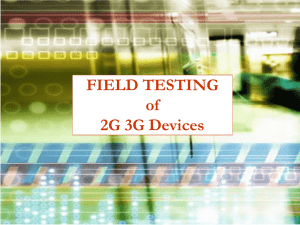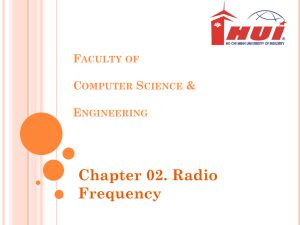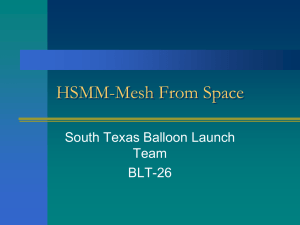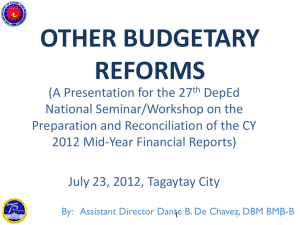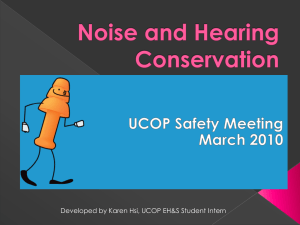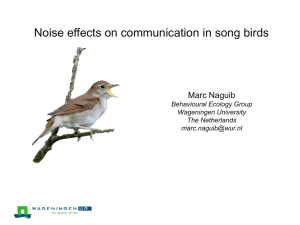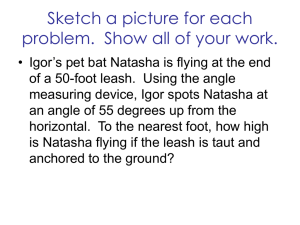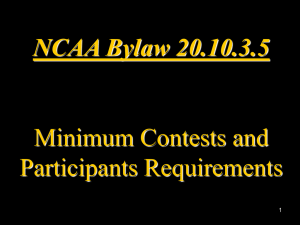ppt - Sherwood Engineering Inc.
advertisement
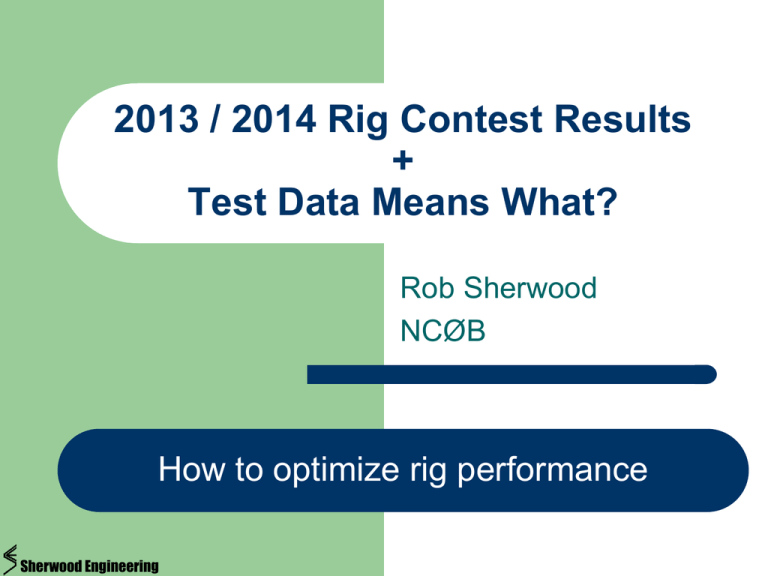
2013 / 2014 Rig Contest Results + Test Data Means What? Rob Sherwood NCØB How to optimize rig performance Sherwood Engineering • What is important in a contest or DX pile-up environment hasn’t changed. • Good Dynamic Range to hear weak signals in the presence of near-by strong signals. • You need a better receiver for CW than for SSB, which I will talk about this afternoon. • 2013 / 2014 Contest performance observations • How does published test data relate to on-air chance of overload? What New Rigs have Shipped? Announced rigs that actually shipped in 2013: Hilberling PT-8000A @ $18,000 Kenwood TS-990S @ $8,000 Flex 6000 series @ $4,300 to $7,500 Ten-Tec Argonaut VI + 418 amp @ $1,780 Elecraft KX3 with KXPA100 amp* @ $1,750 (All of these used in contests in 2013 & 2014) * The KXPA100 shipped in 2013 Comments about the new rigs? Hilberling updated filter boards for better CW performance. Kenwood TS-990 great bandscope with a very clean transmitter Was my favorite contest rig in 2013. Flex finally filled back orders, shipped V 1.00 & V 1.1 software 2013. Version 1.21 shipped April 30, 2014. Excellent electrical performance. UI still being developed. T-T Argonaut VI + 418 amp has excellent QSK (Any QRPers here?) Elecraft KX3 + KXPA100 a flexible QRP / 100 watt option (KX3 QSK not as good as K3 QSK or T-T QSK) How did new rigs actually perform? Hilberling’s new CW filter was a big improvement. The TS-990S was a joy to use on SSB & CW. Flex 6700 performed very well in CQ 160 CW contest, but required two computers. Argonaut VI + 418 + Acom 1000 performed well, but lacks some features. KX3 also worked well in W1BB CW contest but QSK was disappointing Details - Hilberling PT-8000A Covers 160 – 2 meters 16-Pole crystal filters, plus audio DSP All factory hardware and software updates need to be installed. New 250 Hz crystal CW filter selection was mandatory for better CW performance. 250-Hz 16-pole Xtal + 200 Hz audio DSP OK 100-Hz audio DSP in QRM not satisfactory Used in ARRL 160-meter CW contest Details – Kenwood TS-990S Main receiver down conversion all bands Third-order transmit IMD excellent at -40 dB Band scope very effective Excellent low-fatigue receive audio Price competitive with competing flagship products of other OEMs RMDR is its weakest point, but should rarely be an issue in most environments. Used in CQWW SSB, ARRL 10 M & ARRL 160 M CW contests very successfully. Details – Flex 6700 Fantastic band scope with amazing resolution Used 16 hours in CQ 160 meter CW contest Clean audio, very low fatigue, minimal ringing Tuned receiver with external Pod UI still being developed. V1.21 significant update. Preamp gain selections are odd. Required two separate computers, one for N1MM and SmartCAT for band data, plus second computer to actually run SmartSDR. Will the need for two computers be a problem? Second computer can be an iPad with app by Stu Phillips, K6TU Ten-Tec Argonaut VI + 418 Amp QSK with 418 and Acom 1000 worked well DSP noise blanker limited below 725 Hz BW Used Timewave DSP-59+ for extra selectivity and to drive external speaker Reasonable choice for QRP contesters who operate at home and in the field. Does not cover 12 or 6 meters. Are missing bands a big problem? Hands? Ergonomics a bit sparse Details – Elecraft KX3 Amazing tiny radio that performs well Performed well in 2012 Stew Perry contest QSK a disappointment with lots of clicks on receive audio DSP provides good bandwidth control Needs KXPA100 to drive any linear 1.5 kW Opposite sideband rejection is its performance limit, being around 60 dB. May require frequent SSB null calibration Definitely a QRP contester consideration How does published test data relate? In 1975 QST and Ham Radio Magazine changed the way receivers were tested. Before that all we had was data on Sensitivity, Selectivity and maybe Cross Modulation. Now reviews and advertisements touted Dynamic Range, Noise Floor and possibly Noise Figure. (Noise Figure relates to Noise Floor, but is filter bandwidth independent.) What is often not understood is Noise Floor is usually significantly lower than Band Noise. An ITU graph published in the ARRL Handbook gives us a starting point to relate band noise to noise floor. This ITU data is in a 500-Hz bandwidth, just like typical noise floor data. Band Noise vs. Frequency from ARRL Handbook Most Radios are designed for 10 meters It is easy to assume that a -140 dBm noise floor is better than a -130 dBm noise floor. If band noise on 20 meters is typically -110 dBm, of what value is a receiver noise floor that is 20 to 30 dB lower than band noise? The short answer is that it isn’t useful, unless we operate our receiver in an optimum way. (Use your attenuator on the lower bands.) Two things to remember: Band noise easily changes 10 dB depending on beam heading. Optimally receiver noise should be 8 to 10 dB lower than band noise to have minimal effect on receiving weak signals. How does band noise vary by band? If we take the ITU rural data as a starting point, what is typical? 160 meters: 80 meters: 40 meters: 20 meters: 15 meters: 10 meters: -87 dBm -93 dBm -101 dBm -109 dBm -114 dBm -119 dBm That’s a 30+ dB difference in band noise Measured band noise at NC0B 160 meters 8:00 AM MST: 160 meters 4:00 PM MST: 160 meters 6:30 PM MST: -105 dBm -101 dBm -91 dBm January 2014 160 meter CQ CW Contest ITU rural nominal value: -87 dBm Beam Heading, October 2013 0 degrees beam heading: 30 degrees: 60 degrees: 90 degrees: 120 degrees: 150 degrees: 15 meters -124 dBm -124 dBm -118 dBm -114 dBm -113 dBm -114 dBm 10 meters -129 dBm -123 dBm -120 dBm -120 dBm -122 dBm -122 dBm ITU rural nominal value: -114 dBm -119 dBm Typical receiver noise floor values Rig Pro III TS-990 K3 Preamp OFF -132 dBm -127 dBm -130 dBm Preamp ON -140 dBm -138 dBm -138 dBm ITU band noise on 40 meters is around -100 dBm, while typical receiver noise floor (no preamp) is -130 dBm, or 30 dB lower ! What does all this imply? For most radios: Up-conversion / down-conversion On the lower bands, attenuation is often appropriate. There is no point in band noise reading upscale on your S meter. A preamp is rarely needed on 20 meters. A preamp would never be needed on 40 meters and below, assuming the transmit antenna is used on receive. Where do these examples not apply? Direct sampling radios are different Their overload point is higher, and the noise floor is also higher Examples of direct sampling radios: Flex 6300, 6500 or 6700 Perseus receiver (CW Skimmer) * Apache ANAN-100D & ANAN-200D * (* 7 dB preamp always in circuit) (* 20 dB preamp always in the circuit) Some comparison data Rig Noise Floor Preamp Off / On Noise Figure Preamp Off / On Icom Pro III -132 dBm / -140 dBm Elecraft K3 -130 dBm / -138 dBm Kenwood 990S -127 dBm / -138 dBm 12 dB / 4 dB 14 dB / 6 dB 17 dB / 6 dB Flex 6700 26 dB / 12 dB -118 dBm / -132 dBm For classic radios with normal mixers (up-conversion or down-conversion) attenuation is often helpful in potential overload conditions (contests / DX pile-ups) on 40 meters and below. Possibly even on 20 meters. For direct sampling radios, attenuation would rarely be needed, but a preamp would be useful on 15 meters and up. How do we chose a new transceiver? On most bands receivers are too sensitive. Make the most of the radio’s dynamic range by properly using the attenuator and using the preamp only when necessary. Published dynamic range can be misleading, depending on how it is measured. Read the fine print & look at video links on last page. Look at RMDR, as this typically dominates. (RMDR* = Reciprocal Mixing Dynamic Range) [*QST April 2012 for sidebar – Bob Allison] It is a numbers game today! Evaluation in contest conditions is critical. A lab setup can never approximate CQ WW ! Choices today on rig selection We have rigs from $1000 to $18,000 for sale. Many do well in contest conditions. It is hard to evaluate on-air performance from some of the published data. Many aspects of a radio affect contest scores In the end, hopefully you enjoy using your rig on the air ! http://www.NC0B.com Sherwood Engineering http://www.sherwood-engineering.com Videos available on the web: Contest University 2013 http://www.contestuniversity.com/main/page_videos.html Contest University 2011 http://www.pvrc.org/webinar/radioperformance.wmv
